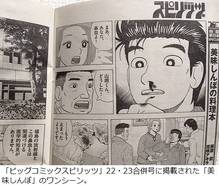 Source: narinari.com
Source: narinari.com For a prefecture still affected by the stigma related to its exposure to radiation from the Daiichi power plant, this depiction elicited a range of comments, mostly criticism of the ‘insensitivity’ of the editors of Shogakukan in illustrating Fukushima in such a negative way (a point of view stressed by the Fukushima prefectural government, who complained that no-one in the prefecture had suffered the type of illnesses depicted in the comic) (J). As an aside, the governments of Osaka City and Osaka Prefecture also objected to the depiction of people suffering from eye and breathing problems as a result of the radioactive waste transported from Fukushima for disposal in the Kansai region (J). Even the federal government got in on the act, with Parliamentary Deputy Environment Minister Ukishima Tomoko stating that it was ‘disappointing’ that Shogakukan had chosen to illustrate Fukushima in such a fashion, especially ‘when the people of Fukushima are doing their best (presumably to overcome the events of 3.11)’, and according to Environment Minister Ishihara Nobuteru, no link has been established between nosebleeds and exposure to radiation - (J) and (J).
The author of the manga series, Kariya Tetsu (72), was reported in January this year as having suffered from a series of nosebleeds after visiting Fukushima Prefecture a number of times since 3.11 (these details were included in an interview with Kariya conducted by the Nichigo Press newspaper in Australia) (J). After the publishing of the controversial comic frames, Kariya directed anyone with claims against them to aim their criticism at him rather than Shogakukan, saying that the responsibility for the frames was his alone (J).
It seems that much of the criticism being directed against both the comic and Kariya stems from a belief that without any scientific basis, Oshinbo has raised the spectre of radiation fallout in a country still coming to terms with the meaning of 3.11, and by doing so has created an unnecessary level of fear and apprehension concerning not only Fukushima Prefecture itself but what it represents – namely, a failure to cope with disaster. While recent months have seen moves towards re-starting nuclear power plants across the country despite widespread anguish at the degree of reliance on nuclear energy, the questions raised by Kariya have certainly sparked renewed debate about the consequences of nuclear accidents and whether the government (any government) can be trusted to deal with them properly. The degree of anger directed at Kariya and Shogakukan suggests that the debate about nuclear power in Japan is a long way from being resolved, and that the anguish of Fukushima still weighs heavily upon the psyche of the nation.
 RSS Feed
RSS Feed